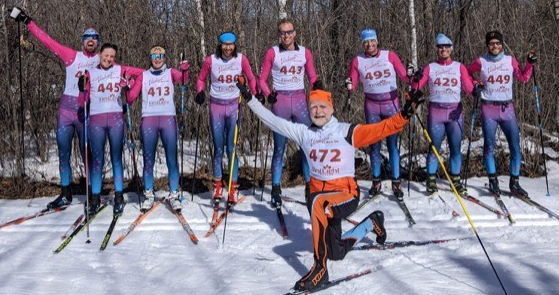Cornering: Here I mean cornering on flats, uphills, and slight downhills. By using the below cornering technique (aka the “marathon skate” around corners) you can generate significant speed coming out of the corner. And, it’s ridiculously fun! Marathon cornering is my favorite thing to do on rollerskis/skis. It doesn’t require much balance and when done correctly, it generates a lot of power.
You can also do this cornering technique on classic skis. According to the 2018 FIS International Ski Competition Rules: “Turning techniques comprise of steps with the inner ski and pushes with the outer ski in order to change skiing direction. The sections of the course where turning techniques are allowed must be clearly marked.”
Here’s how to corner step by step:
1. Pole on the outside cornering ski. This is a pole similar to V-1 that starts when the ski is set down.
2. Next take a small step with your inside ski
3. Step with your outside ski to bring it parallel to your inside ski and as you put it down, immediately begin your poling phase and repeat.
Again, the pole timing is the same as V-1. Here’s a video that explains this well.
When I first learned this cornering technique, I was much better at turning right, likely because I’m a natural left sided V-1er. If one side is easier for you, practice that side but also think about what you are doing and force yourself to do it on the other side. You’ll know you’re getting good when you’re getting your skis up in the air!
 |
| Super impressed with this skier's cornering technique (farthest left skier with yellow on top and blue on bottom) during the 2004 Bemidji High School Relays. |
Transitions: Anytime you are switching technique (i.e. from free skate to V-1 if skating or double pole to kick double pole or striding if classicaling), this is a transition. It’s important to think about where to make that transition. If you are reasonable at V-2, you may want to V-2 into a hill until you begin to “bog down” or lose energy. Then switch to the V-1. Think about where to free skate and whether you’d be faster or slower using the V-1 alternate or V-2. As you approach a corner, think about what technique you will use going into the corner and what technique you will use coming out of the corner. This will depend on whether there’s hills on either side and if they are going down or up.
Practice lane changes for classic skiing. In citizen racing it’s possible you may never employ this technique in actual competition, but it will improve your balance and poling power.
Practice starts and sprints for finishes. If it’s a classic race, play around with double poling off the line versus taking a few short running strides (not recommended for a mass start race). For practicing skate starts, work on the transition from a high-powered double pole into a V-2.
Putting it all together: Whether in practice or racing, think about skiing each part of the course as fast as possible. The terrain, your strength, your strong suits, the conditions, etc, all dictate what technique you should be using when. A lot of skiing is about efficiency and what is most efficient for the skier. Let’s take a gradual uphill for example, I’m strong at double poling and so would usually prefer that to striding but if conditions are really slow, I may need to stride. The same goes for V-2 vs V-1. I know I’m faster V-2ing and will try to stay in a V-2 longer than others because as soon as I start to V-1, I fall behind. I hope you’ve learned from this series to not just think of the uphills as the work in skiing, but to think about how to get faster on the flats, corners, gradual downhills, and steep downhills. These are all “working” parts of the course. I also find it much more fun to ski this way.
 |
| My bro skiing just a few years ago using a combo of the free skate and tuck. |
That concludes this six part series on secrets to being a faster skier. By now your side abs should be getting plenty strong to support all that playing on skis, downhills, and cornering. If anyone is thinking “I only have a few hours a week on skis, I don’t have time to work on these secrets” I’d counter that skiing is a lifelong sport. You will be doing this for another 10, 20, 30, 40, 50, etc more years. Doing these drills will keep you more agile, prevent injury, give you confidence, and help you age on skis. Plus, they are fun and can ease some of the boredom of machine-made snow or golf course loops.
 |
| And should you ever find yourself transitioning to cheering, DO NOT FORGET the boombox (oh yeah, and the video recorder:) |

